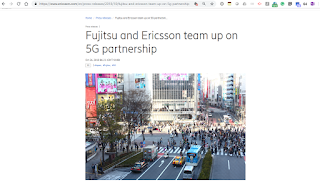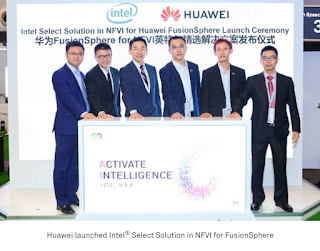Cisco launched its portfolio of Nexus 400 Gigabit Ethernet (400G) switches for large cloud data centers. Field testing is expected in December and general availabity is targeted for the first half of 2019.
Beyond bringing just a new level of speed to the network, Cisco said its Nexus 400G platforms deliver:
 Cisco is supporting QSFP-DD (Quad Small Form Factor – Double Density) modules as "the ideal 400G connectivity option: for all next-generation cloud and other hyperscaledata centers.
Cisco is supporting QSFP-DD (Quad Small Form Factor – Double Density) modules as "the ideal 400G connectivity option: for all next-generation cloud and other hyperscaledata centers.
Cisco said it is also working to take BiDirectional (BiDi) Optical Networking to the 400 Gigabit Ethernet realm, enabling re-use of existing fiber cabling infrastructure when upgrading to higher speed interfaces.
Several models are initially offered.
Cisco Nexus 3400-S -- a 400G programmable switch with 50 Gbps PAM4 Serial-Deserializers (SerDes). It leverages a 12.8-Tbps ASIC for 32 ports of 400G using Quad Small Form-Factor Pluggable – Double Density (QSFP-DD) modules that are backward-compatible with QSFP+, QSFP28, and QSFP56. The Cisco Nexus 3432D-S supports break out for 2x200/50G, 4x100/50G/25G, and 8x50G, supporting up to 128 ports of 100G or up to 168 ports of 50G. At 400G, the Cisco Nexus 3400-S claims the lowest latency in the industry, of 370ns at high-power efficiency.
Cisco Nexus 3408-S is powered by a 12.8-Tbps ASIC with 50 Gbps PAM4 SerDes. It has the following hardware configuration: 4RU, 8-slot chassis; 16 ports of Quad-Small-Form-Factor 28
(QSFP28); 4 ports of Quad Small Form-Factor Pluggable – Double Density (QSFP-DD);
Cisco Nexus 9300-GX switches, also part of the fixed Cisco Nexus 9000 Series Switches series, offers 16 x 400/100-Gbps QSFP-DD ports or 28 x 100/40-Gbps Quad Small Form-Factor Pluggable (QSFP28) and 8 x 400/100-Gbps QSFP-DD ports. The platform introduces a fully backward-compatible 400G optical interface Quad Small Form-Factor Pluggable – Double Density (QSFP-DD) to transparently migrate existing data center fabrics from 40-Gbps and 100-Gbps speeds to 400 Gbps. The platform provides investment protection for customers, delivering highly flexible layer 2 and layer 3 scalability, and performance to meet the changing needs of virtualized data centers and automated cloud environments. Cisco provides two modes of operation for Cisco Nexus 9000 Series Switches. Organizations can deploy Cisco Application Centric Infrastructure (Cisco ACI) or Cisco Nexus switch environments (Cisco NX-OS mode).
"Our 400G switches do more than just bring a new level of speed to customers. They support the delivery of the signature capabilities that customers expect for their modern data-driven workloads and cloud environments,” said Roland Acra, SVP, General Manager Data Center Business Group. “Superfast policy, segmentation and whitelisting. Real-time visibility into packets, flows and events. Smart buffering for big data and machine learning workloads. The ability to prioritize critical traffic on-demand. These are the things that Cisco has delivered to our customers across multiple generations of Nexus switches. And we are doing so again with our new 400G portfolio.”
Beyond bringing just a new level of speed to the network, Cisco said its Nexus 400G platforms deliver:
- Superfast policy, segmentation and whitelisting;
- Real-time visibility into packets, flows and events – beyond just data sampling and system telemetry;
- Smart buffering for big data or storage and machine learning workloads with dynamic packet prioritization; and
- Lowest latency, with an ability to prioritize critical traffic on demand.
 Cisco is supporting QSFP-DD (Quad Small Form Factor – Double Density) modules as "the ideal 400G connectivity option: for all next-generation cloud and other hyperscaledata centers.
Cisco is supporting QSFP-DD (Quad Small Form Factor – Double Density) modules as "the ideal 400G connectivity option: for all next-generation cloud and other hyperscaledata centers.Cisco said it is also working to take BiDirectional (BiDi) Optical Networking to the 400 Gigabit Ethernet realm, enabling re-use of existing fiber cabling infrastructure when upgrading to higher speed interfaces.
Several models are initially offered.
Cisco Nexus 3400-S -- a 400G programmable switch with 50 Gbps PAM4 Serial-Deserializers (SerDes). It leverages a 12.8-Tbps ASIC for 32 ports of 400G using Quad Small Form-Factor Pluggable – Double Density (QSFP-DD) modules that are backward-compatible with QSFP+, QSFP28, and QSFP56. The Cisco Nexus 3432D-S supports break out for 2x200/50G, 4x100/50G/25G, and 8x50G, supporting up to 128 ports of 100G or up to 168 ports of 50G. At 400G, the Cisco Nexus 3400-S claims the lowest latency in the industry, of 370ns at high-power efficiency.
Cisco Nexus 3408-S is powered by a 12.8-Tbps ASIC with 50 Gbps PAM4 SerDes. It has the following hardware configuration: 4RU, 8-slot chassis; 16 ports of Quad-Small-Form-Factor 28
(QSFP28); 4 ports of Quad Small Form-Factor Pluggable – Double Density (QSFP-DD);
Cisco Nexus 9300-GX switches, also part of the fixed Cisco Nexus 9000 Series Switches series, offers 16 x 400/100-Gbps QSFP-DD ports or 28 x 100/40-Gbps Quad Small Form-Factor Pluggable (QSFP28) and 8 x 400/100-Gbps QSFP-DD ports. The platform introduces a fully backward-compatible 400G optical interface Quad Small Form-Factor Pluggable – Double Density (QSFP-DD) to transparently migrate existing data center fabrics from 40-Gbps and 100-Gbps speeds to 400 Gbps. The platform provides investment protection for customers, delivering highly flexible layer 2 and layer 3 scalability, and performance to meet the changing needs of virtualized data centers and automated cloud environments. Cisco provides two modes of operation for Cisco Nexus 9000 Series Switches. Organizations can deploy Cisco Application Centric Infrastructure (Cisco ACI) or Cisco Nexus switch environments (Cisco NX-OS mode).
"Our 400G switches do more than just bring a new level of speed to customers. They support the delivery of the signature capabilities that customers expect for their modern data-driven workloads and cloud environments,” said Roland Acra, SVP, General Manager Data Center Business Group. “Superfast policy, segmentation and whitelisting. Real-time visibility into packets, flows and events. Smart buffering for big data and machine learning workloads. The ability to prioritize critical traffic on-demand. These are the things that Cisco has delivered to our customers across multiple generations of Nexus switches. And we are doing so again with our new 400G portfolio.”























































